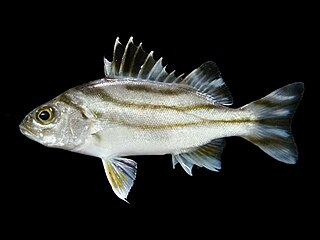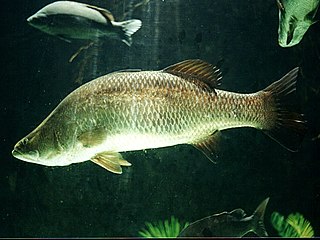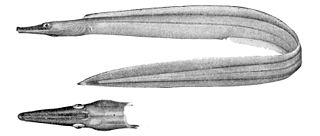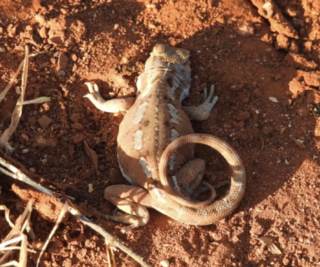
A tuna is a saltwater fish that belongs to the tribe Thunnini, a subgrouping of the Scombridae (mackerel) family. The Thunnini comprise 17 species across five genera, the sizes of which vary greatly, ranging from the bullet tuna up to the Atlantic bluefin tuna, which averages 2 m (6.6 ft) and is believed to live up to 50 years.

Mackerel is a common name applied to a number of different species of pelagic fish, mostly from the family Scombridae. They are found in both temperate and tropical seas, mostly living along the coast or offshore in the oceanic environment.

Herring are various species of forage fish, mostly belonging to the family of Clupeidae.

Wobbegong is the common name given to the 12 species of carpet sharks in the family Orectolobidae. They are found in shallow temperate and tropical waters of the western Pacific Ocean and eastern Indian Ocean, chiefly around Australia and Indonesia, although one species occurs as far north as Japan. The word wobbegong is believed to come from an Australian Aboriginal language, meaning "shaggy beard", referring to the growths around the mouth of the shark of the western Pacific.

The Pedder galaxias is an Australian freshwater fish. It is considered to be extinct in the wild since 2005 by the EPBC Act, and was originally found only in Lake Pedder in Tasmania.

Grunters or tigerperches are ray-finned fishes in the family Terapontidae. This family is part of the superfamily Percoidea of the order Perciformes.

The whitecheek shark or widemouth blackspot shark is a requiem shark of the family Carcharhinidae, found in the Indo-West Pacific Ocean between latitudes 34°N and 25°S. It can reach a length of 1 m. It feeds mainly on fish, cephalopods, and crustaceans. It is a viviparous species, with the female giving birth to up to four live young.

The ornate wobbegong is a species of carpet shark that lives in Australia and possibly other countries in the Western Pacific Ocean. It is coloured golden brown, yellow-green and blueish-grey, and it grows to maximum 120 centimetres (3.9 ft). Described by Charles Walter De Vis in 1883, it is similar in appearance to other Australian wobbegongs and has previously been classified as the same species as the Gulf wobbegong. It is a nocturnal species, hunting at night, and it can bite humans when disturbed. The International Union for Conservation of Nature has listed it as a least-concern species.

Dermophis parviceps is a species of caecilian in the family Dermophiidae. It is found in Costa Rica and Panama, and possibly in Colombia, depending on the source. Common names slender caecilian and La Loma caecilian have been coined for it.

Dendropsophus parviceps is a species of frog in the family Hylidae. It is found in the Amazon Basin of Bolivia, Brazil, Colombia, Ecuador, Peru, and Venezuela. Dendropsophus parviceps is a locally common species with no known threats. These frogs are found on the leaves and branches in primary and secondary tropical rainforest, but also in open spaces close to forests. It is found in moist habitats. It breeds in temporary bodies of water. Eggs are laid in water where the tadpoles develop.

The leathery grunter is a species of ray-finned fish in the family Terapontidae. It is endemic to Queensland (Australia). The eggs are fanned and guarded by the male parent.

Scortum is a genus of Australian fresh and brackish water ray-finned fishes in the family Terapontidae, the grunters.

Scortum barcoo is a species of ray-finned fish in the family Terapontidae, known by the common names Barcoo grunter and jade perch. It is endemic to Australia, where it can be found in certain major rivers, including the Barcoo River. It is reared in hatcheries.

The duck-billed eel, also known as the shortsnouted sorcerer or the smallhead duckbill eel, is an eel in the family Nettastomatidae. It was described by Albert Günther in 1877. It is a marine, deep water-dwelling eel, which is known from the Indo-Pacific and the southeastern Pacific Ocean, including Japan, Hawaii, eastern Australia, southeastern Africa, and Chile. It dwells at a depth range of 60–1190 metres, and inhabits the continental shelf and slope. Males can reach a maximum total length of 83 centimetres.

Ctenophorus butlerorum, also known commonly as Butler's dragon, the Shark Bay heath dragon and the Edel heath dragon, is a species of lizard in the family Agamidae. The species is endemic to Australia.

Ctenophorus parviceps, commonly known as the Gnaraloo heath dragon or northwestern heath dragon is a species of agamid lizard occurring in pale coastal sands and shell grit with open heaths and beach spinifex, between the North West Cape and Carnarvon, Western Australia and on Bernier Island. The Gnaraloo heath dragon is a lizard that can be found along the coast of Western Australia between Exmouth Gulf and Shark Bay, and is also known as the northwestern heath dragon. It is native to Australia and usually inhabits sandy coastal dunes. The species' longevity is 3–50 years and its population density is extremely low. The Gnaraloo heath dragon is a member of the Agamidae family, which contains 15 genera. The lizard is under the Ctenophorus genus which has up to 33 species. This genus shows the most morphological and ecological diversity out of the three large agamid genera. 83% of the lizards in this genus lack a crest, while 17% possess crests. They are smaller than most agamids but do have relatively large heads. The Gnaraloo heath dragon can be differentiated from related species by a series of spines on the tail's base, a pale-grey brown broad vertebral band along its back, and hour-glass bars extending upwards to meet the pale vertebral band. It is usually 45mm in terms of length, measuring from snout to vent.
Smith's small-headed sea snake is a marine snake native to waters around the mouth of the Mekong River in Vietnam.
Scortum neili, Neil's grunter, Tironeus neilica or the Angalarri grunter, is a species of freshwater ray-finned fish, a grunter from the family Terapontidae. It is endemic to the Northern Territory of Australia where it is restricted to the East Baines River and the Angalarri River, which are part of the Victoria River system. The adults are found in small, shady, streams with slow currents over substrates of mixed sand, silt and rock, as well as in deeper rocky pools in gorges. They prefer fresh and clear water at temperatures of 21 and 28 °C with the pH being neural or slightly basic. After spawning the male guard and fan the eggs. This is an uncommon species of grunter which frequently has one or two black blotches which can be placed randomly as well a number of indistinct pale vertical bars on the flanks, and a silvery stripe just beneath its eyes.

















